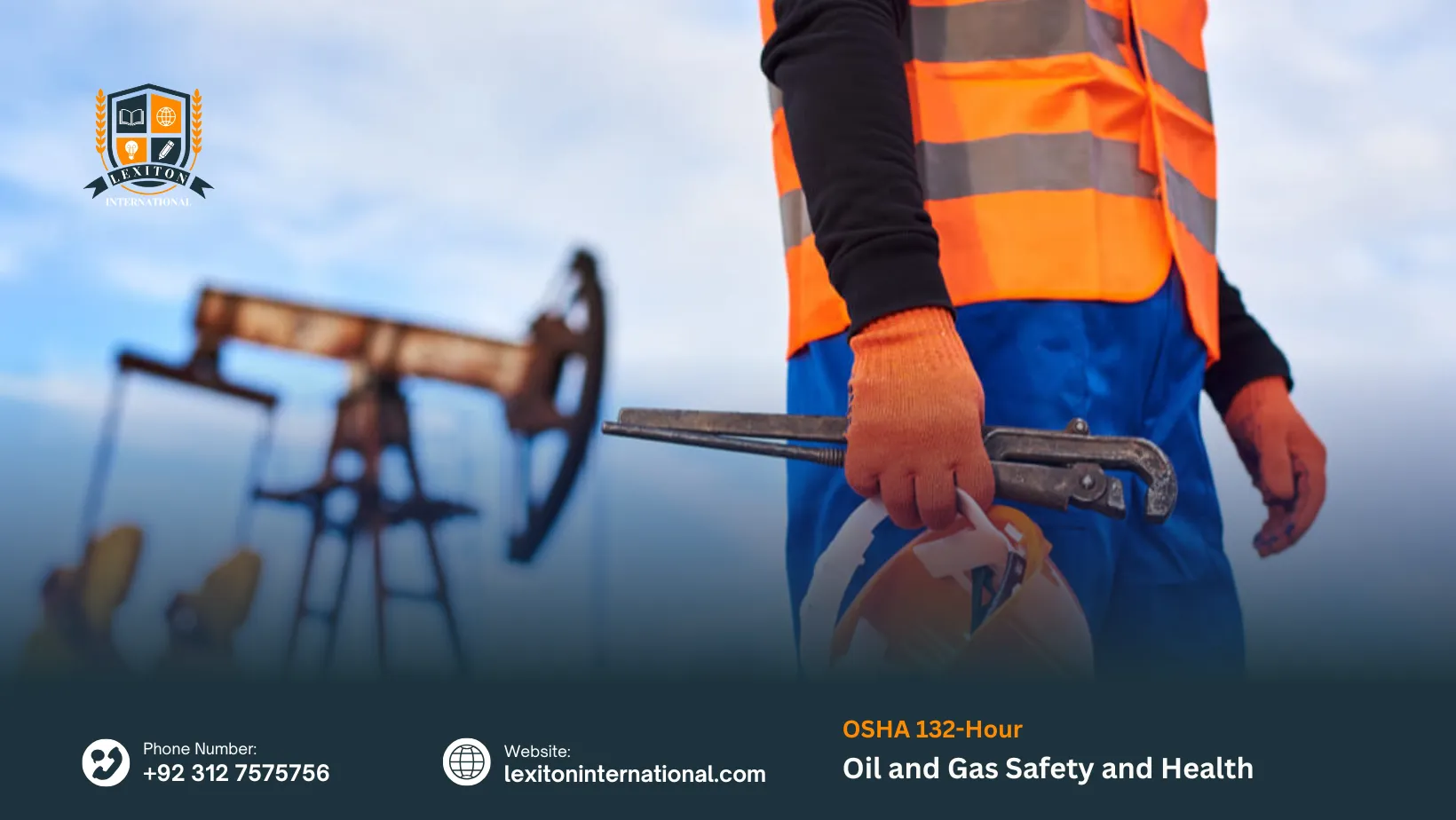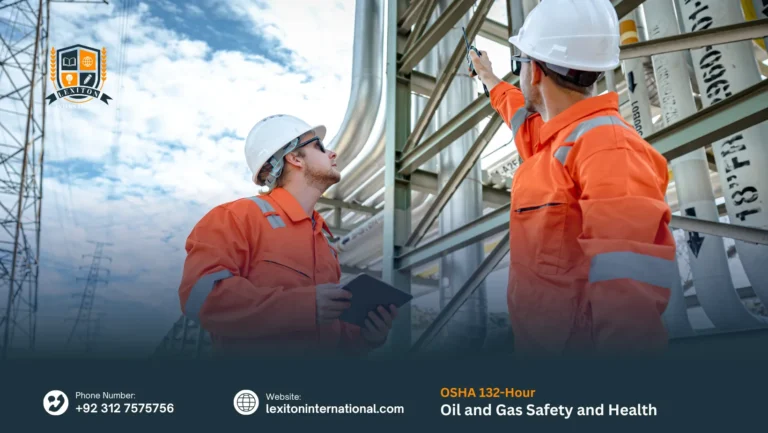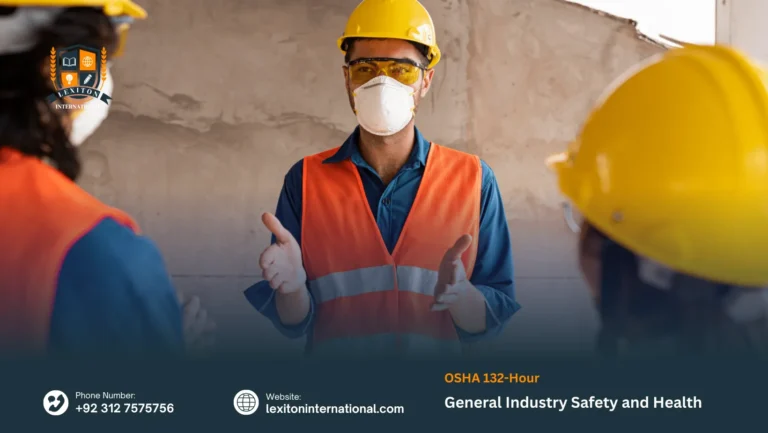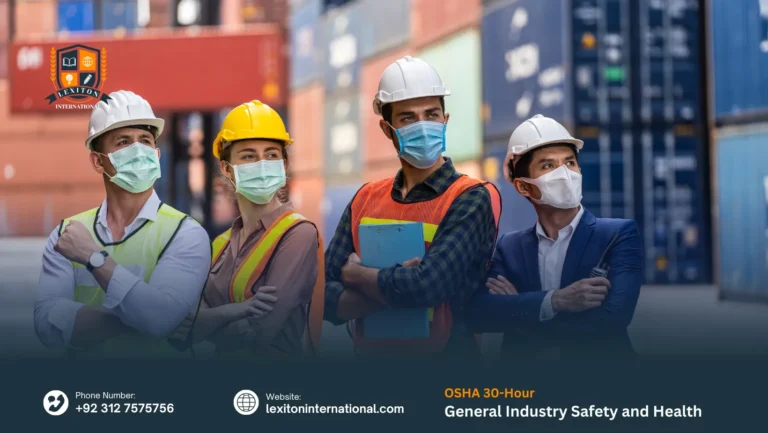The OSHA 132-Hour Oil and Gas Safety and Health Course is a comprehensive training programme designed to enhance workplace safety, compliance, and risk management in the oil and gas industry. Covering both onshore and offshore operations, this course equips professionals with the essential knowledge to identify hazards, prevent accidents, and maintain compliance with OSHA safety standards.
Learners will gain in-depth insights into oilfield hazards, drilling and production safety, refining operations, pipeline management, and environmental health practices. The course also emphasises emergency response planning, hazard communication, and occupational health to prepare participants for real-world challenges in high-risk environments. By completing this certification, professionals strengthen their ability to ensure operational safety while reducing costly risks and downtime.
Recognised internationally, the OSHA 132-Hour training is ideal for engineers, safety officers, supervisors, and managers working in oil rigs, refineries, petrochemical plants, and pipeline operations. Whether you are aiming to advance your career, improve compliance standards in your organisation, or secure international opportunities in the energy sector, this programme provides a strong foundation for success in oil and gas HSE management.
To ensure learners gain the maximum benefit from the OSHA 132-Hour Oil and Gas Safety and Health Course, participants are expected to meet certain academic, professional, and language requirements. These criteria help confirm that learners have the necessary background to understand complex safety standards and apply them effectively in oil and gas environments.
- Age Requirement: Learners should typically be 18 years or older, as the course involves advanced health and safety concepts designed for professional application in high-risk industries.
- Educational Background: A minimum of a high school diploma or equivalent qualification is recommended. Candidates with technical diplomas, degrees, or certifications in engineering, HSE, or related fields will benefit from a stronger foundation.
- Work Experience: Previous experience in oil and gas operations, construction, or industrial environments is highly beneficial. However, motivated beginners interested in pursuing careers in oilfield safety and compliance may also apply.
- English Language Proficiency: Since the course materials and assessments are delivered in English, learners should have a good command of written and spoken English to understand technical terminology and safety guidelines.
- Professional Interest in Safety & Compliance: Ideal for individuals aiming to build or advance a career in oil and gas health, safety, and environmental (HSE) management, quality compliance, or operational risk control.
Mandatory Units
This qualification, the OSHA 132-Hour Oil and Gas Safety and Health, consists of 10 mandatory units.
By completing the OSHA 132-Hour Oil and Gas Safety and Health course, participants will achieve the following advanced learning outcomes across ten study units:
1. Understand Advanced OSHA Regulations and Standards
- Interpret and apply advanced OSHA regulations specific to oil and gas operations, ensuring comprehensive compliance.
- Explain the legal implications and organizational consequences of non-compliance with OSHA standards.
- Implement strategies to remain current with evolving regulations and integrate them into daily workplace practices.
2. Advanced Hazard Identification and Risk Assessment
- Utilize advanced tools and methodologies to identify potential hazards in drilling, refining, pipeline, and offshore environments.
- Conduct detailed risk assessments to prioritize hazards based on severity and likelihood of occurrence.
- Develop and implement proactive risk management strategies to mitigate workplace risks effectively.
3. Process Safety Management (PSM)
- Implement and maintain OSHA-compliant PSM systems in line with 29 CFR 1910.119.
- Conduct process hazard analyses (PHAs) and manage change processes to reduce the risk of major chemical incidents.
- Monitor and evaluate the effectiveness of PSM systems through audits, inspections, and continuous improvement measures.
4. Emergency Preparedness and Response Planning
- Develop and implement comprehensive emergency action plans tailored to diverse workplace scenarios.
- Conduct regular drills and simulations to prepare employees for fires, chemical releases, and other emergencies.
- Evaluate response effectiveness through post-incident analysis and feedback mechanisms.
5. Health and Environmental Hazards
- Identify and assess workplace health hazards including chemical exposures, ergonomic risks, and environmental impacts.
- Apply preventive measures and engineering controls to protect worker well-being.
- Monitor environmental conditions and adopt sustainability practices to minimize ecological footprint.
6. Leadership and Safety Culture
- Promote safety awareness and accountability across all levels of the organization.
- Demonstrate leadership in fostering a culture of safety and continuous improvement.
- Strengthen communication strategies that support effective safety management.
7. Advanced Personal Protective Equipment (PPE)
- Select appropriate PPE for specific workplace hazards and operational tasks.
- Train employees on correct usage, maintenance, and storage of PPE to ensure compliance and effectiveness.
- Conduct inspections and evaluations to assess the adequacy and condition of PPE provided to workers.
8. Safety Training and Education
- Design and deliver advanced safety training tailored to different employee groups and job roles.
- Measure training effectiveness through performance evaluations and feedback systems.
- Continuously improve training programs to meet evolving OSHA standards and organizational needs.
9. Contractor and Vendor Safety Management
- Establish and enforce strict safety requirements for contractors and vendors working in oil and gas operations.
- Monitor compliance with OSHA regulations and hold contractors accountable for performance.
- Conduct safety audits of contractor activities to ensure alignment with organizational safety objectives.
10. Regulatory Compliance and Auditing
- Conduct audits and inspections to assess compliance with OSHA regulations and global industry standards.
- Implement corrective actions and process improvements based on audit findings.
- Maintain accurate documentation to demonstrate compliance and support regulatory inspections.
The OSHA 132-Hour Oil and Gas Safety and Health Course is designed for professionals, graduates, and organisations working in the high-risk oil and gas sector. It prepares learners to handle safety, compliance, and operational risks across drilling, refining, and pipeline operations.
Oil and Gas Engineers Seeking Specialisation
- Engineers working in upstream, midstream, or downstream sectors who want to specialise in safety and compliance.
- Professionals aiming to enhance their understanding of OSHA standards and oilfield safety practices.
- Engineers looking to progress into supervisory or safety management roles.
- Individuals interested in bridging technical expertise with occupational health and safety.
- Engineers preparing for international opportunities in regions with strict OSHA compliance.
- Professionals seeking to add safety credentials to strengthen their career profile.
- Engineers aiming to take on multidisciplinary responsibilities in safety, risk, and compliance.
HSE (Health, Safety & Environment) Professionals
- Safety officers and managers already working in oil and gas operations who want advanced OSHA-based training.
- HSE professionals seeking to formalise their skills with internationally recognised certification.
- Individuals responsible for conducting audits, inspections, or risk assessments.
- Safety trainers or consultants aiming to update their knowledge of oilfield hazards and compliance frameworks.
- Professionals looking to advance into leadership roles within HSE departments.
- Workers seeking career mobility within global oil and gas projects.
- Candidates preparing to work in industries where OSHA compliance is a legal requirement.
Oilfield Supervisors & Site Managers
- Supervisors overseeing drilling rigs, refineries, or pipeline projects who must enforce safety regulations.
- Managers responsible for implementing hazard control and accident prevention strategies.
- Site leaders seeking to improve their skills in emergency preparedness and incident reporting.
- Individuals aiming to strengthen their team leadership with OSHA-aligned safety training.
- Professionals responsible for coordinating between workers, contractors, and compliance officers.
- Managers wanting to reduce risks and costly downtime through better safety practices.
- Leaders preparing for senior roles in project safety and operations management.
Recent Graduates and Aspiring Professionals
- Graduates with engineering, technical, or HSE backgrounds looking to enter the oil and gas industry.
- Students who want to gain a competitive edge by adding OSHA-recognised certification to their profile.
- Individuals interested in building a career in safety management within oilfield operations.
- Young professionals aiming to secure jobs in offshore and onshore oil and gas projects.
- Learners who want to transition from academic studies to practical, safety-focused industry roles.
- Graduates targeting international markets where OSHA certification is valued.
- Candidates seeking an entry-level advantage in high-demand oilfield safety jobs.
Career Changers Entering the Oil and Gas Sector
- Individuals from construction, mining, or industrial fields wanting to shift into oil and gas safety.
- Professionals looking for stable, high-demand roles with strong salary potential.
- Workers eager to retrain in health and safety to align with international industry requirements.
- Candidates aiming to apply transferable skills in inspection, risk management, or compliance.
- People seeking long-term career growth in a global industry.
- Those interested in contributing to safer, more sustainable oil and gas operations.
- Mid-career professionals seeking to diversify into HSE leadership roles.
Organisations and Employers Training Their Workforce
- Companies operating in oil and gas that want staff trained in OSHA-based safety and compliance.
- Employers aiming to reduce workplace accidents, incidents, and non-compliance penalties.
- Organisations preparing for external audits and certifications in safety standards.
- Firms seeking to enhance productivity through better safety awareness among employees.
- Employers committed to staff development and international compliance standards.
- Companies aiming to improve their reputation by prioritising worker safety.
- Contractors looking to meet client and government safety requirements.
Professionals Seeking International Opportunities
- Candidates aiming to work in regions like the Middle East, North America, and Asia where OSHA training is mandatory.
- Professionals targeting offshore projects, including oil rigs and marine operations.
- Workers planning to join multinational companies with strict HSE compliance standards.
- Individuals who want globally recognised safety certification to boost employability.
- Professionals aiming for roles in oil refining, petrochemicals, and pipeline operations abroad.
- Engineers and safety officers interested in high-paying jobs in international oil and gas markets.
- Learners preparing for migration or overseas contracts that require OSHA qualifications.
Completing the OSHA 132-Hour Oil and Gas Safety and Health Course opens doors to advanced career opportunities, higher education, and international prospects. The qualification equips learners with the knowledge and confidence to take on leadership roles in one of the world’s most safety-critical industries.
Career Advancement in Oil and Gas Safety
- Graduates can secure senior roles such as HSE Manager, Safety Supervisor, or Compliance Specialist.
- Enhances eligibility for site management positions where OSHA standards are mandatory.
- Strengthens employability in both offshore and onshore oil and gas projects.
- Provides credentials that help professionals transition into consultancy or auditing roles.
- Offers an advantage in competitive hiring markets, especially for leadership positions.
- Expands career options into risk management, operations, and inspection.
- Builds a foundation for long-term career stability in the oil and gas industry.
Higher-Level Training and Diplomas
- Learners can progress to advanced OSHA courses in construction, industrial hygiene, or process safety.
- Provides a strong pathway into Diploma.
- Supports eligibility for advanced HSE qualifications such as IOSH or ISO Lead Auditor training.
- Helps learners prepare for certifications in Process Safety Management (PSM) and hazard analysis.
- Strengthens readiness for postgraduate diplomas in HSE or related engineering fields.
- Opens opportunities for advanced study in occupational safety and environmental management.
- Builds academic credibility for those aiming to pursue master’s degrees in HSE management.
Professional Certifications and Specialisations
- Equips professionals to pursue Six Sigma, Lean Safety, or Root Cause Analysis certifications.
- Supports certification in incident investigation, fire safety, and emergency management.
- Provides the foundation to become a Certified Safety Professional (CSP) or equivalent.
- Strengthens profiles for OSHA Outreach Trainer Certification, enabling graduates to teach safety.
- Offers eligibility for specialised certifications in offshore safety, confined space entry, and hazardous materials handling.
- Encourages continuous professional development in technical and leadership areas.
- Prepares learners for niche roles in environmental compliance and sustainability within oil and gas.
International Employment Prospects
- Widely recognised across global oil and gas markets, including the Middle East, North America, and Asia.
- Essential for candidates applying for jobs in oil rigs, refineries, petrochemical plants, and pipeline projects.
- Meets safety requirements of multinational companies and international contractors.
- Enhances employability in offshore drilling operations where OSHA compliance is enforced.
- Prepares learners for migration or overseas contracts with strict safety standards.
- Provides credentials required for government-approved oilfield projects abroad.
- Boosts global career opportunities in both private and public sectors.
Leadership and Consultancy Pathways
- Graduates can progress into senior-level leadership roles within HSE departments.
- Opens doors to consultancy roles advising firms on OSHA standards and compliance strategies.
- Provides the skills to develop and implement company-wide safety management systems.
- Prepares professionals to conduct audits, inspections, and training at an organisational level.
- Enables career progression into policy-making and compliance advisory positions.
- Builds capacity for mentoring and coaching junior safety professionals.
- Positions learners as trusted leaders in safety culture transformation.
Organisational Impact and Growth
- Employers benefit from professionals capable of reducing accidents and non-compliance penalties.
- Trained staff can support ISO and OSHA audit readiness, boosting company reputation.
- Enhances workplace productivity by minimising risks and costly project delays.
- Strengthens a company’s ability to meet client, legal, and environmental safety requirements.
- Improves global competitiveness by aligning operations with international safety standards.
- Supports sustainability initiatives by integrating environmental health and safety practices.
- Helps organisations develop a long-term safety culture led by certified professionals.
Curious About This Course?





